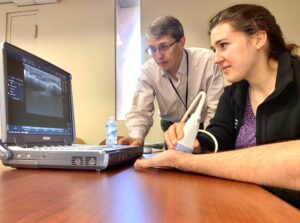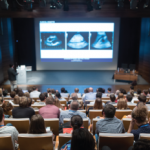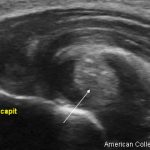Dr. Kissin (EK): I was drawn to ultrasound by the potential it offers to give instant feedback on physical exam findings. Is this joint boggy or are the soft tissues fatty? I thought that having gold standard feedback would help improve my exam skills. I also sought more certainty in rheumatology, a field where uncertainty is the norm. It seemed clear to me that more definite knowledge about the presence of joint effusions and synovial hyperemia should be helpful in making more reasoned treatment decisions.
TR: How does one learn ultrasound in rheumatology?
JA: There are a couple different training pathways: Both the ACR and USSONAR offer training. When you finish USSONAR, you have scanned a large number of joints to identify anatomy and interpret pathology.

The process of learning MSK ultrasound—carpal tunnel views. Scanning: Eva Petrow, MD
(rheumatology fellow, Boston Medical Center), being scanned: Berk Degirmenci, MD
[mobile-ad name="Advert 2"](rheumatology fellow, Boston Medical Center), mentoring: Eugene Kissin, MD, RhMSUS
(rheumatology program director, Boston Medical Center).
By the time the program ends, you receive a certificate that confirms you’ve gone through vetted rigorous training. You really need to learn how to do it appropriately by a certain standard. [Editor’s note: See the “Learn More” sidebar below for more information on both the ACR and USSONAR programs.]
TR: Dr. Kissin, why did you create USSONAR? What did that journey look like? How has it grown over the years?
EK: When I started learning musculoskeletal ultrasound around 2000, I did not have a local mentor, so options included book study, radiology-based weekend courses or travel to Europe to study with rheumatologists there. There was also a short workshop at the ACR that was sufficient to “light the fire,” but needed more fuel.
We realized that radiologist application of musculoskeletal ultrasound was substantially different from what we needed in rheumatology [and faced] resistance to rheumatologists using and billing for ultrasound.
Thus, our group started USSONAR in an effort to make the learning process easier for other rheumatologists in the U.S., as well as to create a peer group to help withstand the external forces and allow the use of this valuable tool to flourish in our profession.
In our 16th year, we now have well over 60 mentor-teachers and over 700 members. We have published a number of collaborative research projects and have had some positive impact on the regulatory and reimbursement environment.



